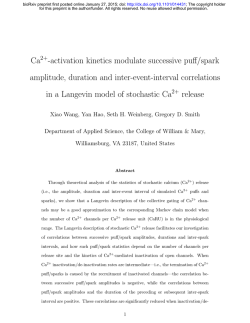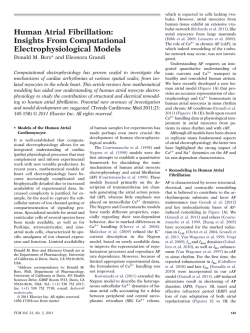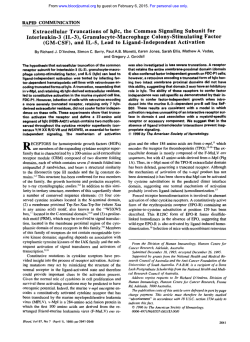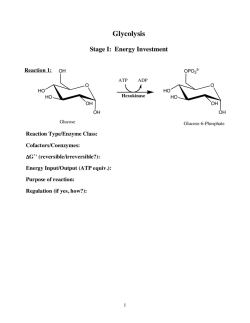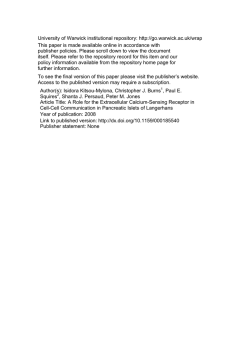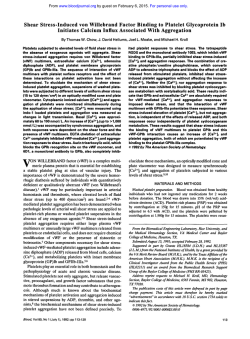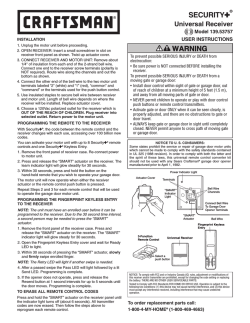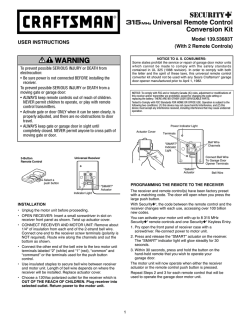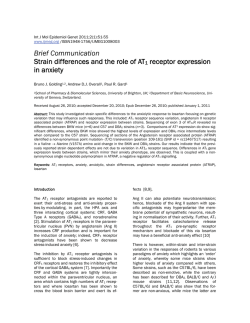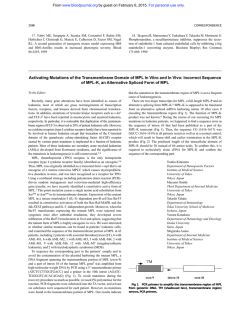
ATP-Stimulated Ca Influx and Phospholipase D
Journal of Neurochemistry Lippincott Williams & Wilkins, Inc., Philadelphia © 1999 International Society for Neurochemistry ATP-Stimulated Ca2⫹ Influx and Phospholipase D Activities of a Rat Brain-Derived Type-2 Astrocyte Cell Line, RBA-2, Are Mediated Through P2X7 Receptors Synthia H. Sun, Lian-Bin Lin, Amos C. Hung, and *Jon-Son Kuo Institute of Neuroscience, National Yang Ming University, Taipei; and *Taichung Veteran General Hospital, Taichung, Taiwan, R.O.C. Abstract: This study characterizes and examines the P2 receptor-mediated signal transduction pathway of a rat brain-derived type 2 astrocyte cell line, RBA-2. ATP induced Ca2⫹ influx and activated phospholipase D (PLD). The ATP-stimulated Ca2⫹ influx was inhibited by pretreating cells with P2 receptor antagonist, pyridoxalphosphate-6-azophenyl-2⬘,4⬘-disulfonic acid (PPADS), in a concentration-dependent manner. The agonist 2⬘and 3⬘-O-(4-benzoylbenzoyl)adenosine 5⬘-triphosphate (BzATP) stimulated the largest increases in intracellular Ca2⫹ concentrations ([Ca2⫹]i); ATP, 2-methylthioadenosine triphosphate tetrasodium, and ATP␥S were much less effective, whereas UTP, ADP, ␣,-methylene-ATP, and ,␥-methylene-ATP were ineffective. Furthermore, removal of extracellular Mg2⫹ enhanced the ATP- and BzATP-stimulated increases in [Ca2⫹]i. BzATP stimulated PLD in a concentration- and time-dependent manner that could be abolished by removal of extracellular Ca2⫹ and was inhibited by suramin, PPADS, and oxidized ATP. In addition, PLD activities were activated by the Ca2⫹ mobilization agent, ionomycin, in an extracellular Ca2⫹ concentration-dependent manner. Both staurosporine and prolonged phorbol ester treatment inhibited BzATP-stimulated PLD activity. Taken together, these data indicate that activation of the P2X7 receptors induces Ca2⫹ influx and stimulates a Ca2⫹-dependent PLD in RBA-2 astrocytes. Furthermore, protein kinase C regulates this PLD. Key Words: ATP—2⬘- and 3⬘-O-(4-benzoylbenzoyl)adenosine 5⬘-triphosphate —Ca2⫹ influx—Phospholipase D —P2X7 receptor—Type-2 astrocytes. J. Neurochem. 73, 334 –343 (1999). tion regarding the function and pharmacology of neurotransmitter receptor subtypes on type-2 astrocytes is very limited. The P2 receptors were classified initially into three groups: (a) the G protein-coupled P2Y class, which upon activation induces phosphoinositide hydrolysis and Ca2⫹ release; (b) the cation channel P2X class, which induces rapid depolarization of membranes; and (c) the nonselective pore-forming P2Z class, which induces cytolytic activities in macrophages and other types of cells. These receptors have been shown to be widely distributed in the CNS (Dubyak and ElMoatassim, 1993; Burnstock, 1997). In general, astrocytes possess metabotropic P2Y receptors, which induce Ca2⫹ release from intracellular stores (Pearce et al., 1989; Kastritsis et al., 1992; King et al., 1996), and P2Z receptors, which induce Ca2⫹ influx from extracellular space (Ballerini et al., 1996). Activation of both types of receptors leads to increases in intracellular free Ca2⫹ concentration ([Ca2⫹]i). Thus, ATP, which is recognized as a neurotransmitter that is coreleased from synapses (Burnstock, 1972), might play an important role in neuron–astrocyte interaction. It is known that activation of the P2Z receptor requires a high concentration of ATP (El-Moatassim and Dubyak, 1993); the activation allows a bidirectional increase in Received December 1, 1998; revised manuscript received February 12, 1999; accepted March 1, 1999. Address correspondence and reprint requests to Dr. S. H. Sun at Institute of Neuroscience, National Yang Ming University, #155, Section 2, Li-Non Street, Shi-Pai, Taipei, Taiwan, R.O.C. Abbreviations used: ATP␥S, adenosine 5⬘-O-(3-thiotriphosphate); BzATP, 2⬘- and 3⬘-O-(4-benzoylbenzoyl)adenosine 5⬘-triphosphate; [Ca2⫹]i, intracellular free Ca2⫹ concentration; ECL, enhanced chemiluminescence; GFAP, glial fibrillary acidic protein; GS, glutamine synthetase; 2-MeSATP, 2-methylthioadenosine triphosphate tetrasodium; ␣,-methylene-ATP, ␣,-methyleneadenosine 5⬘-triphosphate dilithium; ,␥-methylene-ATP, ,␥-methyleneadenosine 5⬘-triphosphate tetrasodium; oATP, oxidized ATP; PBS, phosphate-buffered saline; PEt, phosphatidylethanol; PKC, protein kinase C; PL, phospholipid; PLD, phospholipase D; PMA, phorbol 12-myristate 13-acetate; PPADS, pyridoxalphosphate-6-azophenyl-2⬘,4⬘-disulfonic acid. Type-2 astrocytes were first described in optic nerves. They have stellate morphology, are glial fibrillary acidic protein (GFAP)- and A2B5-positive, and extend processes to the nodes of Ranvier in vivo (Raff, 1989). They are also found in other regions of the brain (Gallo et al., 1989; Usowicz et al., 1989; Dave et al., 1991; Inagaki et al., 1991). Although early reports revealed that type-2 astrocytes possess a variety of neurotransmitter receptors, due to the low yield of these cells obtained by mechanical shaking from mixed glial cultures, informa334 P2X7 STIMULATES Ca2⫹ INFLUX AND PLD plasma membrane permeability to molecules as large as 900 Da and induces release of endogenous molecules (Steinberg et al., 1987). It is interesting that, in several types of immunoresponsive and secretory cells, the P2Z receptor-stimulated Ca2⫹ influx has been shown to be closely associated with activation of phospholipase D (PLD) in a ligand-occupied-dependent manner (ElMoatassim and Dubyak, 1992, 1993; Gargett et al., 1996; Humphreys and Dubyak, 1996). Nevertheless, P2Z-associated PLD activity has never been characterized in the nervous system. Recently, the P2Z receptor was cloned from rat brain and showed sequence homology to the P2X receptor, so it was renamed P2X7 (Surprenant et al., 1996). The classification of P2 receptors is now grouped preferentially into the metabotropic P2Y and ionotropic P2X receptors (Fredholm et al., 1997). In this study, we show that the extracellular ATPelicited Ca2⫹ influx is associated with activation of PLD in a rat brain-derived type-2 astrocyte cell line, RBA-2, which is positive to GFAP, glutamine synthetase (GS), and A2B5. Pharmacological analysis suggests that these responses are mediated through the 2⬘- and 3⬘-O-(4benzoylbenzoyl)adenosine 5⬘-triphosphate (BzATP)sensitive P2X7 (P2Z) receptors. In addition, we provide evidence that protein kinase C (PKC) is involved in the regulation of the P2X7-associated PLD in these astrocytes. MATERIALS AND METHODS Materials ATP, adenosine 5⬘-O-(3-thiotriphosphate) (ATP␥S), BzATP, nifedipine, goat anti-rabbit IgG, oxidized ATP (oATP), phorbol 12-myristate 13-acetate (PMA), pyridoxalphosphate-6-azophenyl-2⬘,4⬘-disulfonic acid (PPADS), secondary antibody rabbit anti-mouse IgG conjugated with horseradish peroxidase, and suramin were from Sigma (St. Louis, MO, U.S.A.). ␣,-Methyleneadenosine 5⬘-triphosphate dilithium (␣,-methyleneATP), ,␥-methyleneadenosine 5⬘-triphosphate tetrasodium (,␥-methylene-ATP), 2-methylthioadenosine triphosphate tetrasodium (2-MeSATP), staurosporine, and thapsigargin were from Research Biochemicals International (Natick, MA, U.S.A.). Phosphatidylethanol (PEt) was from Biomol Research Laboratories Inc. (Plymouth Meeting, PA, U.S.A.). Fetal bovine serum and gentamicin were from GibcoBRL (Gaithersburg, MD, U.S.A.). First antibody anti-A2B5 was from Boehringer Mannheim GmbH (Mannheim, Germany), and antiGFAP and anti-GS were from Chemicon International (Temecula, CA, U.S.A.). Secondary antibody goat anti-mouse IgM was from Jackson ImmunoResearch Laboratories, Inc. (West Grove, PA, U.S.A.). Radioactively labeled [9,10(n)3 H]palmitic acid (specific activity 51.0 Ci/mmol) and the enhanced chemiluminescence (ECL) system were from Amersham Life Science (Buckinghamshire, U.K.). Culture flasks and dishes were from Corning Laboratory Sciences Co. (Corning, NY, U.S.A.). HPTLC plates (Kieselgel 60, 10 ⫻ 10 cm) and organic solvents were from E. Merck (Darmstadt, Germany). Medical x-ray film was from Fuji Photo Film Co., Ltd. (Tokyo, Japan). Cell culture of RBA-2 astrocyte cell line The RBA-2 cell line developed for this study was a subclone of the RBA-1 cell line, which was established originally 335 through continuous passages for 3 years of primary astrocyteenriched cultures isolated from brains of newborn JAR-2, F51 rats (Japanese Research Center of Tissue Culture, Dokkyo University School of Medicine) by Dr. Teh-Cheng Jou (Jou and Akimoto, 1983). Before this study, cells were cultured, and morphological examination revealed that 66 ⫾ 7% of RBA-1 cells were small (15–20 m), round, and process-bearing and had the stellate morphology. These cells were then subjected to a serial dilution method and cultured in 96-well plates. One clone with small and stellate morphology was selected and continuously maintained in F10 medium (pH 6.2, adjusted with bicarbonate) supplemented with 10% fetal bovine serum and gentamicin (50 g/ml). The cells were maintained by using 0.25 mM EDTA in 0.02 M phosphate buffer and stock cultured in T-75 flasks. All experiments were conducted within 10 passages of the cells used. Immunocytochemical analysis of type-2 astrocyte markers To analyze the expression of astrocyte marker proteins, RBA-2 cells were subcultured at a density of 2 ⫻ 104 cells/cm2 on 9 ⫻ 24 mm rectangular glass coverslips (Matsunami, Japan) and placed in a six-well plate for at least 3 days. Cells were stained with first antibodies against anti-GFAP, anti-GS, or anti-A2B5. After five washes with phosphate-buffered saline (PBS) containing 0.05% Tween 20, the coverslips were treated with a 1:250 dilution of a secondary antibody, rabbit antimouse IgG conjugated with horseradish peroxidase. Color determination was conducted by the 3,3⬘-diaminobenzidine method with nuclei stained with hematoxylin. All negative controls for each first antibody were conducted by using secondary antibody only. The photomicrographs were taken with an Olympus BH2 microscope (Olympus, Japan). Western blot analysis of GFAP and GS RBA-2 cells were subcultured into 100-mm dishes, washed, scraped, centrifuged, and resuspended by the addition of 400 l of wash buffer (0.02 M phosphate buffer containing 0.1% glucose) and 100 l of lysis buffer (5 mM Tris-HCl, 5 mM EDTA, 2 mM phenylmethanesulfonyl fluoride, 10 mM Nethylmaleimide, 0.6% sodium dodecyl sulfate, and 200 M leupeptin, pH 8.0) in an ice-cold water bath. Cells were homogenized with a Polytron. Protein levels were analyzed by the method of Lowry et al. (1951) using bovine serum albumin as the standard, and aliquots of homogenate protein (50 g) were loaded onto each lane of 12.5% sodium dodecyl sulfate–polyacrylamide gel for electrophoresis according to Laemmli (1970). After separation, the proteins were transferred to nitrocellulose sheets using a Semi-Dry Trans-Blot (Pharmacia LKB Multiphor II, U.S.A.). For detection of GFAP and GS, nonspecific binding sites were blocked by soaking the protein-loaded nitrocellulose sheets for 30 min in a solution of PBS containing 0.05% Tween 20 and 5% dried skim milk. The sheet was then reacted with a 1:250 dilution of monoclonal anti-GFAP or anti-GS antibody. Then after five washes with PBS containing 0.05% Tween 20, the sheets were treated with a 1:10,000 dilution of a secondary antibody, rabbit anti-mouse IgG, conjugated with horseradish peroxidase (Sigma). The blots were then washed thoroughly, dried, reacted with ECL immunodetection reagents (Amersham), and visualized by autoradiography using Fuji medical x-ray film. Measurement of [Ca2ⴙ]i Increases in [Ca2⫹]i were determined by using the fluorescent Ca2⫹ indicator fura-2 methods described by Grynkiewicz J. Neurochem., Vol. 73, No. 1, 1999 336 S. H. SUN ET AL. et al. (1985) and Ou et al. (1997). In brief, RBA-2 cells were suspended at a density of 1 ⫻ 107 cells/ml in serum-free F10 medium containing fura-2 acetoxymethyl ester (5 M) and incubated for 30 min at 37°C. The cells were then centrifuged at 700 g for 5 min, rinsed twice with serum-free F10 medium to remove the excess fura-2 acetoxymethyl ester, resuspended in serum supplemented with F10 culture medium at a density of 4 ⫻ 106/ml, and left at room temperature until use. Before measurement, the cell suspension (0.5 ml) was diluted with 0.5 ml of loading buffer (150 mM NaCl, 5 mM KCl, 1 mM MgCl2, 2.2 mM CaCl2, 5 mM glucose, 10 mM HEPES at pH 7.4), centrifuged at 700 g at room temperature for 3 min, rinsed twice with 1 ml of loading buffer, resuspended in 2.5 ml of loading buffer, and then transferred to a 3-ml cuvette positioned in a thermostat-regulated (37°C) sample chamber of a dualexcitation beam spectrofluorometer (SPEX, model CM1T111, Edison, NJ, U.S.A.) with continuous stirring. Fluorescence ratios were measured by an alternative wavelength time scanning at 340 and 380 nm; emission was at 505 nm. Calibration of the fluorescent signal in terms of [Ca2⫹]i was performed as described by Grynkiewicz et al. (1985). To elucidate whether ATP stimulates Ca2⫹ release from intracellular stores, [Ca2⫹]i was measured by pretreating the cells with thapsigargin (1 M) for 3 min at room temperature. To elucidate whether ATP stimulates Ca2⫹ influx, [Ca2⫹]i was measured by resuspending the cells in a nominally Ca2⫹-free loading buffer system (150 mM NaCl, 5 mM KCl, 1 mM MgCl2, 5 mM glucose, 10 mM HEPES at pH 7.4, in the absence of EDTA). To elucidate whether ATP activates voltage-sensitive Ca2⫹ channels, [Ca2⫹]i was measured by resuspending cells in loading buffer containing nifedipine (a voltage-sensitive Ca2⫹-channel blocker). The cell suspension was then placed inside the thermostat-regulated sample chamber. To characterize the P2 receptor, [Ca2⫹]i was measured in the presence of eight P2 agonists: BzATP, ATP, 2-MeSATP, ATP␥S, ADP, UTP, ␣,-methylene-ATP, and ,␥-methyleneATP. These agents were added to the cell suspension at the times indicated. To measure the effect of the P2 receptor antagonist, the cells were resuspended in loading buffer in the presence of 1–100 M PPADS, incubated at room temperature for 1 min, centrifuged, rinsed one time with loading buffer, and resuspended in fresh loading buffer. The sample was then placed inside the sample chamber, and the effect of ATP was investigated. ATP-stimulated [Ca2⫹]i was also investigated using cells that had been resuspended in a Mg2⫹-free loading buffer system (150 mM NaCl, 5 mM KCl, 2.2 mM CaCl2, 5 mM glucose, 10 mM HEPES at pH 7.4) in separate experiments. To calculate the net increase in [Ca2⫹]i, the basal level was recorded 60 s after the sample was placed in the sample chamber and before the addition of agonist. The peak level was recorded ⬃10 – 40 s after the addition of the agonist. Net increases in [Ca2⫹]i were calculated by subtracting the basal level of [Ca2⫹]i from peak levels. PLD assay PLD activity was measured according to the original method of Kobayashi and Kanfer (1987) and Liscovitch (1989) by analyzing the accumulation of PEt in the presence of 300 mM ethanol. In brief, RBA-2 astrocytes (1 ⫻ 106 cells/dish) were subcultured into 60-mm dishes and cultured for 2 days. Cells were then labeled with 1 Ci/ml [9,10(n)3 H]palmitic acid (specific activity 51.0 Ci/mmol) in F10 medium, pH 6.2, and supplemented with 2.5% fetal bovine serum for 18 h. After the labeled medium was removed, the J. Neurochem., Vol. 73, No. 1, 1999 cells were rinsed with wash buffer and cultured in 2 ml of loading buffer supplemented with 300 mM ethanol in the presence of the agonist at 37°C for the lengths of time indicated. The reactions were stopped by aspiration, followed by addition of 1.3 ml of ice-cold methanol. The cells were scraped from the culture dish and transferred to a borosilicate glass test tube (13 ⫻ 100 mm), and the dish was scraped again after the addition of 1 ml of water. The lipids were extracted by the addition of 2.7 ml of chloroform, after which the sample was mixed by vortexing and centrifuging at 400 g for 5 min to allow phase separation. The lower organic phases were transferred to new test tubes, where they were evaporated to dryness (Sun et al., 1997). The lipids were then redissolved in 200 l of chloroform and applied to 1% potassium oxalate-preimpregnated 10 ⫻ 10 cm Kieselgel 60 HPTLC plates (E. Merck). Additional unlabeled PEt was also applied to each sample, and the plates were separated by a one-dimensional solvent system using the upper layer of a mixture of ethyl acetate/isooctane/acetic acid/H2O (65:10:10:50, by volume). After development, the plates were dried, the lipid bands were visualized by exposure to iodine vapor, and the PEt and phospholipid (PL) bands were scraped into scintillation vials for counting by scintillation spectrometry. The radioactivities of PEt were standardized as dpm PEt/100,000 dpm in PL (El-Moatassim and Dubyak, 1993). RESULTS RBA-2 is a type-2 astrocyte cell line RBA-2 cells were first characterized by immunocytochemical analysis of astrocyte markers. As shown in Fig. 1A, these cells were positive for GFAP, GS, and A2B5. Morphological examination of a total of 4,696 cells from 20 randomly taken photomicrographs revealed that 97 ⫾ 2% of RBA-2 cells had small (15–20 m), processbearing morphology typical of type-2 astrocytes, whereas 2.9 ⫾ 0.8% were flat and were microglial cells, macrophages, or flat astrocytes. A comparison of the astrocyte-specific protein expression in C6 glioma cells and RBA-2 cells is indicated in Fig. 1B, which shows that the antibody against GFAP revealed a single band at 50 kDa, and the antibody against GS revealed a single band at 45 kDa in RBA-2 astrocytes. As shown in Fig. 1B, RBA-2 cells were highly enriched in GS. Together, these results indicate that RBA-2 cells exhibit the characteristics of type-2 astrocytes. ATP-stimulated Ca2ⴙ influx is mediated through P2 receptors As indicated in Fig. 2A, 1 mM ATP stimulated a sustained increase in [Ca2⫹]i. Treatment of these cells with 1 M thapsigargin raised the basal level of [Ca2⫹]i, and ATP further stimulated the increase in [Ca2⫹]i in these cells. As shown in Fig. 2B, when cells were incubated in a nominally Ca2⫹-free loading buffer system (⫺Ca2⫹), the addition of ATP failed to elicit an increase in [Ca2⫹]i, but the reintroduction of 2 mM extracellular Ca2⫹ (⫹Ca2⫹) led to an increase in [Ca2⫹]i. Addition of ATP (1 mM) to cells treated with a 5 M concentration of the voltage-sensitive Ca2⫹-channel blocker, nifedipine, stimulated increases in [Ca2⫹]i (Fig. 2C). Together, P2X7 STIMULATES Ca2⫹ INFLUX AND PLD 337 FIG. 1. Characterization of RBA-2 astrocytes. A: RBA-2 expressed GFAP, GS, and A2B5 antigens. Cells were subcultured on glass coverslips, placed in a six-well plate for 3 days, and then stained with first antibodies: (1) anti-GFAP, (2) anti-GS, (3) antiA2B5, or (4) none as indicated. After washing, the coverslips were treated with a 1:250 dilution of a secondary antibody, rabbit anti-mouse IgG conjugated with horseradish peroxidase. Color determination was conducted by the 3,3⬘-diaminobenzidine method with nuclei counterstained with hematoxylin. Scale bar ⫽ 20 m. B: Western blot analysis of the expression of GFAP and GS in RBA-2 astrocytes (lanes 1) and C6 glioma cells (lanes 2). Aliquots of proteins (50 g of protein) from cell lysates were separated by gel electrophoresis, transblotted to nitrocellulose membrane. Detection of GFAP (50 kDa) and GS (45 kDa) was performed by reacting with anti-GFAP or anti-GS antibodies visualized by the ECL method as indicated by the arrows. the extracellular [Ca2⫹]-dependent ATP-stimulated increases in [Ca2⫹]i did not involve Ca2⫹ release from intracellular stores, nor were they mediated through voltage-sensitive Ca2⫹ channels. To determine whether the ATP-stimulated Ca2⫹ influx is mediated through P2 receptors, the cells were pretreated with a common P2 receptor antagonist, PPADS, for 1 min, washed, and then analyzed for ATP-stimulated increases in [Ca2⫹]i. This treatment did not affect the basal level of [Ca2⫹]i nor those of thapsigargin- and ionomycin-raised [Ca2⫹]i, indicating that the pretreatment may not affect Ca2⫹ measurement (data not shown). As shown in Fig. 2D, the ATP-stimulated Ca2⫹ influx was inhibited by 10 –100 M PPADS in a concentration-dependent manner. PPADS at 1, 3, 10, 30, and 100 M inhibited ATP-stimulated increases in [Ca2⫹]i by 23 ⫾ 9%, 39 ⫾ 11%, 57 ⫾ 6%, 86 ⫾ 3%, and 95 ⫾ 4%, respectively (n ⫽ 3). The IC50 of the effect of PPADS was ⬃10 M. We concluded that ATP stimulates Ca2⫹ influx through a P2 receptor. ATP-stimulated increases in [Ca2ⴙ]i are mediated through a BzATP-sensitive P2X7 (P2Z) receptor To determine which of the P2 receptors mediates the ATP-stimulated Ca2⫹ influx in RBA-2 astrocytes, we tested the response of these cells to eight ATP analogues (El-Moatassim and Dubyak, 1993; Harden et al., 1995; Burnstock, 1997; Boarder and Hourani, 1998). As indicated in Fig. 3A, ATP, 2-MeSATP, and ATP␥S induced moderate increases in [Ca2⫹]i, and BzATP stimulated a marked increase in [Ca2⫹]i in these cells. ATP, 2-MeSATP, and ATP␥S induced net increases in [Ca2⫹]i of 70 ⫾ 16, 38 ⫾ 4, and 27 ⫾ 1 nM, respectively (Fig. 3B). By contrast, a 1 mM concentration of ADP, UTP, ␣,methylene-ATP, or ,␥-methylene-ATP was ineffective (data not shown). Figure 3C demonstrates the concentration dependence of increases in [Ca2⫹]i by ATP (0.3–2 mM) and BzATP (10 M to 1 mM) stimulation; marked effects of BzATP were observed. The maximal effect of BzATP was at 500 M, which elicited a net increase in [Ca2⫹]i of almost 1 M. EC50 values of ATP and BzATP J. Neurochem., Vol. 73, No. 1, 1999 338 S. H. SUN ET AL. dylcholine, the major PLD analyzed by this method could be attributed to phosphatidylcholine-PLD. Effects of ATP and BzATP on PLD activity were examined by measuring the accumulation of PEt in the presence of 300 mM ethanol. As shown in Fig. 5A, BzATP was much more potent than ATP in the stimulation of PEt accumulation in RBA-2 astrocytes. The BzATP-stimulated PLD activities were concentration-dependent with a maximal effect at 100 M. The EC50 of BzATPstimulated PLD was ⬃40 M. As shown in Fig. 5B, the FIG. 2. ATP stimulation of Ca2⫹ influx, but not Ca2⫹ release through P2 receptors. RBA-2 astrocytes were preloaded with fura-2, rinsed, and resuspended (A) in loading buffer in the presence or the absence of 1 M thapsigargin (TG) and incubated for 3 min, (B) in nominally Ca2⫹-free loading buffer, or (C) in loading buffer containing 5 M nifedipine (NF). D: In the case of P2 antagonist, the fura-2-preloaded cells were resuspended in loading buffer containing 0 M (trace 1), 10 M (trace 2), 30 M (trace 3), and 100 M (trace 4) PPADS, incubated for 1 min, washed once with loading buffer, and resuspended in fresh loading buffer. The cell suspensions were then placed inside a thermostat-regulated sample chamber. The addition of ATP (1 mM) or CaCl2 (2 mM) is indicated by an arrow, and the fluorescences of fura-2 and fura-2-Ca2⫹ were recorded and [Ca2⫹]i calculated as described in Materials and Methods. The experiments were performed at least three times, and results were reproducible. were ⬃450 and ⬃170 M, respectively. Taken together, the ATP-stimulated Ca2⫹ influx was mediated probably through the BzATP-sensitive P2X7 receptors in these cells. As it is known that extracellular [Mg2⫹] affects poreforming activities and Ca2⫹ influx of P2X7 receptors (Wiley et al., 1993; Song and Chueh, 1996; Ross et al., 1997), we then tested ATP- or BzATP-stimulated [Ca2⫹]i in the absence of extracellular Mg2⫹. By incubating cells in a Mg2⫹-free loading buffer system, the ATP- (Fig. 4A) and BzATP-stimulated (Fig. 4B) increases in [Ca2⫹]i were enhanced as compared with those using the Mg2⫹-supplemented loading buffer system. These results combined confirm that ATP-stimulated Ca2⫹ influx is mediated through P2X7 receptors in RBA-2 astrocytes. Stimulation of the P2X7 receptor is associated with activation of PLD in RBA-2 astrocytes To analyze the signal transduction pathway mediation of the P2X7 receptor in RBA-2 astrocytes, we determined if ATP and BzATP stimulate PLD activity in these cells. RBA-2 astrocytes were prelabeled with [3H]palmitic acid for 18 h. As most of the labeling (74.0 ⫾ 0.8%; n ⫽ 3) was distributed in membrane phosphatiJ. Neurochem., Vol. 73, No. 1, 1999 FIG. 3. ATP analogue-stimulated increases in [Ca2⫹]i. The fura2-preloaded RBA-2 astrocytes were rinsed, suspended in loading buffer, and stimulated with ATP analogues. Then the fluorescences of fura-2 and fura-2-Ca2⫹ were recorded and [Ca2⫹]i calculated as described in Materials and Methods. A: Traces of increases in [Ca2⫹]i stimulated by 1 mM each of BzATP (trace 1), ATP (trace 2), 2-MeSATP (trace 3), and ATP␥S (trace 4). B: Net increases in [Ca2⫹]i stimulated by 1 mM each of ATP, 2MeSATP, and ATP␥S (n ⫽ 3). C: The concentration dependence of (䊐) ATP- or (■) BzATP-stimulated net increase in [Ca2⫹]i. The net increases in [Ca2⫹]i were calculated by subtracting the basal level of [Ca2⫹]i from peak levels. Data represent the means ⫾ SD from three determinations. P2X7 STIMULATES Ca2⫹ INFLUX AND PLD 339 PEt. In addition, 100 – 600 M oATP inhibited the BzATP-stimulated PLD activities (Fig. 5D), but 1–10 M oATP was ineffective. Furthermore, oATP also inhibited the ATP-stimulated PLD activities and the BzATP-stimulated phosphatidic acid accumulation in these cells (data not shown). Thus, the P2X7 receptor is responsible for the action of BzATP-mediated PLD activity in RBA-2 astrocytes. FIG. 4. Effect of extracellular Mg2⫹ on (A) ATP- and (B) BzATPstimulated increases in [Ca2⫹]i. The fura-2-preloaded RBA-2 astrocytes were suspended in loading buffer supplemented with (䊐) 0 mM Mg2⫹ or (■) 1 mM Mg2⫹ and stimulated with various concentrations of ATP or BzATP. The fluorescences of fura-2 and fura-2-Ca2⫹ were recorded and [Ca2⫹]i calculated as described in Materials and Methods. Net increases in [Ca2⫹]i were calculated by subtracting the basal level of [Ca2⫹]i from peak levels. Data represent the means ⫾ SD from three determinations. ATP- and BzATP-stimulated PLD activities were timedependent. The time-course studies revealed that a fourfold increase in BzATP-stimulated PEt was observed at 1 min, and the maximal effect was found at 10 min (Fig. 5B). To elucidate whether BzATP-stimulated PLD activity is associated with the activation of P2X7 receptors, we analyzed the effect of two common P2 antagonists, PPADS and suramin, on BzATP-stimulated PEt accumulation. As shown in Fig. 5C, PPADS and suramin both caused concentration-dependent inhibitions of BzATPstimulated PEt accumulation. Values of IC50 for PPAD and suramin were ⬃5 and ⬃40 M, respectively. These results confirm that the BzATP-stimulated PLD activities are mediated through P2 receptors. To confirm whether BzATP-stimulated PLD activities are mediated through the P2X7 receptor, we measured the PEt accumulation in cells pretreated with the selective P2X7 receptor antagonist, oATP. Pretreatment of cells with 600 M oATP in labeled medium for 2 h did not alter the basal levels of Extracellular Ca2ⴙ is required for the activation of PLD activity To confirm whether nucleotide-stimulated PLD is associated with P2X7-induced Ca2⫹ influx, we then analyzed the ATP- or BzATP-stimulated PEt accumulation in a nominally Ca2⫹-free buffer system. As shown in Fig. 6A, the ATP- or BzATP-stimulated PEt accumulations were abolished when cells were incubated in a nominally Ca2⫹-free buffer system, suggesting that the nucleotide-induced Ca2⫹ influx is required for the activation of PLD in these cells. To establish the linkage between activation of PLD and increases in [Ca2⫹]i, we analyzed ionomycin-stimulated PEt accumulations in the presence of various concentrations of extracellular Ca2⫹ (0 –2.2 mM). As indicated in Fig. 6B, a minimum of 0.44 mM extracellular Ca2⫹ was required for ionomycin to induce PEt accumulation; thereafter, PLD activity increased with increasing extracellular [Ca2⫹]. In parallel with this observation, ionomycin-induced [Ca2⫹]i also increased with increasing medium [Ca2⫹]i (Fig. 6C). The average (n ⫽ 2) ionomycin-induced net increases in [Ca2⫹]i in the presence of 0, 0.44, 1.1, and 2.2 mM extracellular Ca2⫹ were 39, 196, 808, and 6,258 nM, respectively. Taken together, these results suggest that activation of PLD requires an increase in [Ca2⫹]i. PKC is involved in the activation of P2X7-associated PLD To examine whether PKC regulates the P2X7-associated PLD activation in RBA-2 cells, we analyzed BzATP-stimulated PEt accumulation in the presence of the PKC inhibitor, staurosporine, or in cells pretreated with PMA for 4 h. An initial time-course study indicated that the PKC activator, PMA, stimulated increases in PEt accumulations from 5 to 30 min, with a maximal effect observed at 30 min; but the effect diminished with prolonged PMA treatment, and after 4 h PMA-induced PLD activity was abolished (data not shown). BzATP-stimulated PEt accumulation was inhibited by 50% in the presence of 100 and 1,000 nM staurosporine (Fig. 7A) and also in cells pretreated with 100 nM PMA for 4 h (Fig. 7B), suggesting that PKC regulates, in part if not all, the BzATP-stimulated PLD activities in RBA-2 astrocytes. DISCUSSION In the present study, a permanent type-2 astrocyte cell line, RBA-2, was established with a purity of 97% and used for repetitive and continuous biochemical analyses. J. Neurochem., Vol. 73, No. 1, 1999 340 S. H. SUN ET AL. FIG. 5. Activation of P2X7 receptor stimulation of PLD activities. RBA-2 astrocytes were subcultured in 60-mm dishes (1 ⫻ 106 cells/dish), labeled with [3H]palmitate for 18 h, washed, and incubated in loading buffer containing 300 mM ethanol (A) supplemented with various concentrations of (䊐) ATP or (■) BzATP and incubated for 15 min, or (B) supplemented with 1 mM ATP or 100 M BzATP and incubated for various lengths of time at 37°C. C: In the case of P2 receptor antagonist, the prelabeled cells were incubated in loading buffer containing 300 mM ethanol and supplemented with various concentrations of the common P2 antagonists, PPADS (F) or suramin (■), and incubated for 5 min at 37°C. BzATP at 40 M was then added, and the cells were incubated further at 37°C for 10 min. D: In the case of the selective P2X7 receptor antagonist, cells were subcultured into 30-mm dishes (5 ⫻ 105 cells/dish), labeled with [3H]palmitic acid for 18 h, and treated with the indicated concentrations of oATP for 2 h. Cells were then washed and incubated in loading buffer containing 300 mM ethanol in the presence or absence of 40 M BzATP for 10 min. PLD was assayed by measuring the accumulation of PEt and standardized with 105 dpm in PL as described in Materials and Methods. Data represent the means ⫾ SD of dpm PEt/100,000 dpm in PL from three determinations. *Significantly different from the controls (nonpaired Student’s t test, p ⱕ 0.05). The experiments were performed twice, and results were reproducible. This cell line provides an accessible system for the analysis of neurotransmitter-stimulated second messenger formation that may provide insight into physiological functioning of these astrocytes. The RBA-2 cell line was established in a similar way to another permanent type-2 lineage cell culture, L3, which was established through repetitive passaging and selection from mixed glial cultures (Aloisi et al., 1990). Previous studies have shown that type-2 astrocytes, but not type-1 astrocytes, accumulate GABA (Aloisi et al., 1988; Gallo et al., 1989). Immunocytochemical and western blot analysis revealed that RBA-2 astrocytes are highly enriched in GS (Fig. 1), which is an important astrocyte enzyme for metabolizing glutamate and GABA in the brain (Norenberg and Martinez-Hernandez, 1979; Patel and Hunt, 1985). Thus, the high level of GS expression suggests that one of the important physiological functions of RBA-2 astrocytes is probably to metabolize these neurotransmitters. In the present study, we demonstrate ATP-stimulated Ca2⫹ influx in RBA-2 astrocytes, which is blocked by PPADS. P2 receptor agonists (ADP, UTP, ␣,-methylene-ATP, and ,␥-methylene-ATP) were ineffective, whereas BzATP was the most effective in raising [Ca2⫹]i. Thus, RBA-2 appears to possess only a P2X7 receptor but not a P2Y receptor, nor the P2X1– 6 receptors. The pharmacological profile of RBA-2 P2X7 resembles that of the cloned rat brain P2X7 receptor (Surprenant et al., 1996). In separate experiments, we demJ. Neurochem., Vol. 73, No. 1, 1999 onstrate that ATP and BzATP stimulate PLD activities in RBA-2 astrocytes, and that suramin and PPADS antagonize BzATP-induced PLD activity. In addition, pretreatment of cells with the selective P2X7 receptor blocker, oATP, blocks BzATP-stimulated PLD activity. Furthermore, BzATP stimulates lucifer yellow admission into RBA-2 astrocytes (data not shown), confirming that BzATP induces characteristic pore-forming activities of P2X7 receptors in these cells. Together, these results are in agreement with the initial findings in immunoresponsive cells that stimulation of the P2X7 receptor is closely associated with the activation of PLD (El-Moatassim and Dubyak, 1992, 1993; Gargett et al., 1996; Humphreys and Dubyak, 1996). In the present study, the BzATP-stimulated increase in [Ca2⫹]i is 10 times greater than that of ATP. This result is consistent with a common notion that BzATP is much more potent than ATP in activation of the P2X7 receptor (Dubyak and El-Moatassim, 1993). Pharmacological selectivity for the P2X7 receptor is ATP4⫺ ⫽ BzATP Ⰷ ATP (Harden et al., 1995), and therefore ATP is a partial agonist with lower efficiency. At concentrations of ATP higher than 1 mM and BzATP concentrations higher than 500 M, the increases in [Ca2⫹]i become smaller, suggesting that high concentrations of ATP and BzATP may chelate some Ca2⫹ and interfere with [Ca2⫹]i measurement (Fig. 3C). In addition, high concentrations of BzATP (ⱖ1 mM) slightly quenched fluo- P2X7 STIMULATES Ca2⫹ INFLUX AND PLD 341 rescence of fura-2 in the medium (data not shown). Thus, the lowering of the maximum of BzATP-increased [Ca2⫹]i could be due to interference of fura-2 released from pores or lysed cells. Activation of PLD is known to be regulated via multiple pathways involving Ca2⫹, PKC, G protein, and protein tyrosine kinase (Billah, 1993; Briscoe et al., 1995; Klein et al., 1995; Exton, 1997). A direct relationship between [Ca2⫹]i and PLD activation has been demonstrated (Wu et al., 1992). Early results indicated that ATP-activated PLD was dependent on extracellular Ca2⫹ and PKC in endothelial cells (Purkiss and Boarder, 1992). However, activation of PLD may be a secondary response of the P2X7 signal pathways (Harden et al., 1995). Nevertheless, as our results reveal that BzATPactivated PLD is inhibited by suramin, PPADS, and oATP and is abolished in nominally Ca2⫹-free buffer conditions, we can conclude that activation of PLD is closely associated with the activation of the P2X7 receptor in these astrocytes. We have not completely ruled out the possibility that RBA-2 may possess other P2 receptors, because there is a discrepancy between the concentrations evoking in- FIG. 6. Roles of Ca2⫹ in the activation of PLD. A: The [3H]palmitic acid-prelabeled RBA-2 astrocytes were washed and incubated in loading buffer containing 300 mM ethanol and supplemented with 2.2 mM Ca2⫹ (⫹Ca2⫹) or without Ca2⫹ (⫺Ca2⫹) and with (䊐) 1 mM ATP or (■) 100 M BzATP or without nucleotides (basal) at 37°C for 15 min. B: The prelabeled cells were incubated in loading buffer containing 300 mM ethanol, 0 –2.2 mM Ca2⫹ as indicated, and 2 M ionomycin at 37°C for 15 min. The reactions were stopped by aspiration; lipids were extracted, applied to HPTLC, and separated by a one-dimensional solvent system. After lipid separation, the bands corresponding to PEt and PL were scraped, and the radioactivities determined by scintillation spectrophotometry. Data represent the means ⫾ SD of dpm PEt/100,000 dpm in PL from three determinations. *Significantly different from the respective controls (nonpaired Student’s t test, p ⱕ 0.05). C: Traces of increases in [Ca2⫹]i, which were assayed by incubating the fura-2-preloaded cells in loading buffer supplemented with 0 –2.2 mM Ca2⫹ with ionomycin (2 M ). The experiments were performed twice, and the results were reproducible. FIG. 7. Involvement of PKC in BzATP-stimulated PLD activity. A: RBA-2 astrocytes were prelabeled with [3H]palmitic acid, incubated in loading buffer in the presence or absence of the PKC inhibitor staurosporine (100 and 1,000 nM), and stimulated with BzATP (100 M) in the presence of 300 mM ethanol for 15 min. B: The prelabeled cells were pretreated (■) with or (䊐) without PMA (100 nM) for 4 h, and then stimulated with 100 or 200 M BzATP in loading buffer in the presence of 300 mM ethanol for 15 min. Reactions were stopped by aspiration; the lipids were extracted and applied to HPTLC, and PEt and PL were separated by a one-dimensional solvent system. Radioactivities of PEt and PL were determined by scintillation spectrophotometry. Data represent the means ⫾ SD of dpm PEt/100,000 dpm in PL from three determinations. *Significantly different from the respective control (nonpaired Student’s t test, p ⱕ 0.05). J. Neurochem., Vol. 73, No. 1, 1999 342 S. H. SUN ET AL. creases in [Ca2⫹]i and the accumulation of PEt. BzATP maximally stimulated the accumulation of PEt at a concentration of 100 M (Fig. 5A). In contrast, at the same concentration, BzATP evoked a submaximal increase in [Ca2⫹]i (Fig. 3C). Nevertheless, RBA-2 astrocytes appear to resemble human lymphocytes, which possess only the P2X7 (P2Z) receptor (Gargett et al., 1996). In human lymphocytes, P2X7-mediated PLD activity is directly proportional to the influx of divalent cations; thapsigargin raised [Ca2⫹]i, but failed to stimulate PLD activity in these cells. In the present study, ionomycin induced significant increases in PEt accumulation, and at an extracellular [Ca2⫹] of ⱖ0.44 mM, the ionomycinstimulated PEt accumulations were proportional to extracellular [Ca2⫹]. This result suggests that the ionomycin-increased [Ca2⫹]i must reach a threshold concentration before eliciting PLD activation. However, ionomycin caused a tremendous increase of [Ca2⫹]i (⬃6 M), far more than that by 100 M BzATP (364 ⫾ 81 nM), but ionomycin-induced PEt accumulation was less than that of BzATP. Thus, although the activation of PLD is associated with P2X7-induced Ca2⫹ influx, it is not crucially related to [Ca2⫹]i. Gargett et al. (1996) suggested that Ca2⫹ influx accumulates in the microenvironment near the P2X7 pore, and that this is important to the activation of PLD; local increases in Ca2⫹ may stimulate translocation of PKC to the membrane to regulate the PLD. Therefore, PKC may be the limiting factor in the activation of PLD in RBA-2 astrocytes. Taken together, these results suggest that P2X7-induced Ca2⫹ influx is required for PLD, and the regulation of PLD may depend on a mechanism that is closely associated with the P2X7 receptor. Possibly, PKC plays a rate-limiting regulatory role in P2X7-activated PLD in these cells. By using the PKC activator O-tetradecanoylphorbol 13-acetate and inhibitor H-7, Gustavsson and Hansson (1990) revealed that PKC regulates PLD activities in cultured astrocytes. Our results indicate that PKC is involved in the activation of a P2X7-associated PLD in RBA-2 astrocytes. Recently, PKC⑀ was found to mediate the ATP- and UTP-activated PLD in renal mesangial cells (Pfeilschifter and Merriweather, 1993), and PKC␣ was found to exert a synergistic effect with RhoA in the activation of membrane-bound PLD in HL60 cells (Ohguchi et al., 1996). We have found that RBA-2 astrocytes express at least seven PKC isozymes (data not shown). Thus, P2X7-activated PLD could be regulated by one or more of the PKC isozymes or may involve some other Ca2⫹-dependent mechanism. Earlier, the Ca2⫹/calmodulin protein kinase II-activated pathway, distinct from that of PKC, was shown to be a potential mediator in P2X7-mediated PLD activation in human lymphocytes (Humphreys and Dubyak, 1996). Nevertheless, Gargett and Wiley (1997) found that inhibition by KN-62 is not mediated by Ca2⫹/calmodulin protein kinase II, but occurs directly at the receptor. Recently, a 335-amino acid sequence on an extracellular domain of the human lymphocyte P2X7 receptor, but not of the rat J. Neurochem., Vol. 73, No. 1, 1999 P2X7 receptor, has been identified as the domain sensitive to KN-62 (Humphreys et al., 1998). In the present study, KN-62 (0.5–5 M) did not inhibit BzATP-stimulated PLD activities in RBA-2 astrocytes (data not shown). Although the molecular identity of the RBA-2 P2X7 receptor is not known, this result indicates that RBA-2 P2X7 closely resembles the cloned rat P2X7 receptor (Surprenant et al., 1996). The exact physiological function of P2X7 in type-2 astrocytes is not clear at this moment. Recently, Ballerini et al. (1996) demonstrated that activation of the P2X7 receptor-induced Ca2⫹ influx is correlated with efflux of purine in cultured rat astrocytes. In microglia, activation of the P2X7 receptor triggers interleukin-1 release (Ferrari et al., 1996). However, both P2X7-associated increases in [Ca2⫹]i and activation of PLD require high concentrations of ATP. The amount of ATP released from synaptic terminals during neuronal transmission, which then diffuses to the astrocyte, probably falls below these high thresholds. Therefore, additional extracellular ATP would have to be provided by (a) the release of cytosolic ATP via intrinsic plasma channels or pores in the absence of irreversible cytolysis, or (b) stimulationinduced release of cytosolic ATP upon sudden breakage of intact cells (Dubyak and El-Moatassim, 1993). Recently, P2X7 immunoreactivities were shown to appear in a necrotic area in the brain by prior occlusion of the middle cerebral artery (Collo et al., 1997). Thus, with pathophysiological conditions, ATP may act via the P2X7 receptor to regulate type-2 astrocytes in the CNS. In conclusion, we demonstrate that P2X7 is the major P2 receptor in a permanent type-2 astrocyte cell line, RBA-2, and that stimulation of P2X7 is closely associated with activation of PLD in these astrocytes. The P2X7-activated PLD is dependent on Ca2⫹ influx and is regulated by PKC. Acknowledgment: We would like to thank Dr. S.-H. Chueh and Dr. F. F. Wang for critical reading of the manuscript. This work was supported by a grant from Taichung Veterans General Hospital, Taiwan, R.O.C. (TVGH-8674011D) and a grant from the National Science Council (NSC 87-2316-B-010-009). REFERENCES Aloisi F., Agresti C., and Levi G. (1988) Establishment, characterization, and evolution of cultures enriched in type 2 astrocytes. J. Neurosci. Res. 21, 188 –198. Aloisi F., Sun D., Levi G., and Welerle H. (1990) Establishment of a permanent rat brain-derived glial cell line as a source of purified oligodendrocyte-type 2 astrocyte lineage cell populations. J. Neurosci. Res. 27, 16 –24. Ballerini P., Rathbone M. P., Di Lorio P., Renzetti A., Giuliani P., D’Alimonte I., Trubiani O., Caciagli F., and Ciccarelli R. (1996) Rat astroglial P2Z (P2X7) receptors regulate intracellular calcium and purine release. Neuroreport 7, 2533–2537. Billah M. M. (1993) Phospholipase D and cell signaling. Curr. Opin. Immunol. 5, 114 –123. Boarder M. R. and Hourani S. M. O. (1998) The regulation of vascular function by P2 receptors: multiple sites and multiple receptors. Trends Pharmacol. Sci. 19, 99 –107. Briscoe C. P., Martin A., Cross M., and Wakelam M. J. O. (1995) The roles of multiple pathways in regulating bombesin-stimulated P2X7 STIMULATES Ca2⫹ INFLUX AND PLD phospholipase D activity in Swiss 3T3 fibroblasts. Biochem. J. 306, 115–122. Burnstock G. (1972) Purinergic nerves. Pharmacol. Rev. 24, 509 –581. Burnstock G. (1997) The past, present and future of purine nucleotides as signaling molecules. Neuropharmacology 36, 1127–1139. Collo G., Neidhart S., Kawashima E., Kosco-Vilbois M., North R. A., and Buell G. (1997) Tissue distribution of P2X7 receptor. Neuropharmacology 36, 1277–1283. Dave V., Gordon G. W., and McCarthy K. D. (1991) Cerebral type 2 astroglia are heterogeneous with respect to their ability to respond to neuroligands linked to calcium mobilization. Glia 4, 440 – 447. Dubyak G. R. and El-Moatassim C. (1993) Signal transduction via P2-purinergic receptors for extracellular ATP and other nucleotides. Am. J. Physiol. 265, C577–C606. El-Moatassim C. and Dubyak G. R. (1992) A novel pathway for the activation of phospholipase D by P2Z purinergic receptors in BAC1.2F5 macrophages. J. Biol. Chem. 267, 23664 –23673. El-Moatassim C. and Dubyak G. R. (1993) Dissociation of the poreforming and phospholipase D activities stimulated via P2Z purinergic receptors in BAC1.2F5 macrophages. J. Biol. Chem. 268, 15571–15578. Exton J. H. (1997) Phospholipase D: enzymology, mechanisms of regulation, and function. Physiol. Rev. 77, 303–321. Ferrari D., Villalba M., Chiozzi P., Falzoni S., Ricciardi-Castagnoli P., and Di Virgilio F. (1996) Mouse microglial cells express a plasma membrane pore gated by extracellular ATP. J. Immunol. 156, 1531–1539. Fredholm B. B., Abbracchio M. P., Burnstock G., Dubual G. R., Harden T. K., Jacobson K. A., Schwabe U., and Williams M. (1997) Towards a revised nomenclature for P1 and P2 receptors. Trends Pharmacol. Sci. 18, 79 – 82. Gallo V., Giovannini C., Suergiu R., and Levi G. (1989) Expression of excitatory amino acid receptors by cerebellar cells of type-2 astrocyte cell lineage. J. Neurochem. 52, 1–9. Gargett C. E. and Wiley J. S. (1997) The isoquinoline derivative KN62 a potent antagonist of the P2Z-receptor of human lymphocytes. Br. J. Pharmacol. 120, 1483–1490. Gargett C. E., Cornish J., and Wiley J. S. (1996) Phospholipase D activation by P2Z-purinoceptor agonists in human lymphocytes is dependent on bivalent cation influx. Biochem. J. 313, 529 –535. Grynkiewicz G., Poenie M., and Tsien R. Y. (1985) A new generation of Ca2⫹ indicators with greatly improved fluorescence properties. J. Biol. Chem. 260, 3440 –3450. Gustavsson L. and Hansson E. (1990) Stimulation of phospholipase D activity by phorbol esters in cultured astrocytes. J. Neurochem. 54, 737–742. Harden T. K., Boyer J. L., and Nicholas R. A. (1995) P2-purinergic receptors: subtype-associated signaling responses and structure. Annu. Rev. Pharmacol. Toxicol. 35, 541–579. Humphreys B. D. and Dubyak G. R. (1996) Induction of the P2Z/P2X7 nucleotide receptor and associated phospholipase D activity by lipopolysaccharide and IFN␥ in human THP-1 monocytic cell line. J. Immunol. 157, 5627–5637. Humphreys B. D., Virginio C., Surprenant A., Rice J., and Dubyak G. R. (1998) Isoquinolines as antagonists of the P2X7 nucleotide receptor: high selectivity for the human versus rat receptor homologues. Mol. Pharmacol. 54, 22–32. Inagaki N., Fukui H., Ito S., Yamatodani A., and Wada H. (1991) Single type-2 astrocytes show multiple independent sites of Ca2⫹ signaling in response to histamine. Proc. Natl. Acad. Sci. USA 88, 4215– 4219. Jou T.-C. and Akimoto K. (1983) Rat brain tissue culture. II. Immunocytochemical staining of astrocytes in monolayer culture using antiserum to glial fibrillary acidic protein. Proc. Natl. Sci. Counc. Repub. China B 7, 488 – 495. Kastritsis C. H. C., Salm A. K., and McCarthy K. (1992) Stimulation of the P2y purinergic receptor on type 1 astroglia results in inositol phosphate formation and calcium mobilization. J. Neurochem. 58, 1277–1284. King B. F., Neary J. T., Zhu Q., Wang S., Norenberg M. D., and Burnstock G. (1996) P2 purinoceptors in rat cortical astrocytes: 343 expression, calcium-imaging and signalling studies. Neuroscience 74, 1187–1196. Klein J., Chalifa V., Liscovitch M., and Lo¨ffelholz K. (1995) Role of phospholipase D activation in nervous system physiology and pathophysiology. J. Neurochem. 65, 1445–1455. Kobayashi M. and Kanfer J. N. (1987) Phosphatidylethanol formation via transphosphatidylation by rat brain synaptosomal phospholipase D. J. Neurochem. 48, 1597–1603. Laemmli U. K. (1970) Cleavage of structural proteins during the assembly of the head of bacteriophage T4. Nature 227, 680 – 685. Liscovitch M. (1989) Phosphatidylethanol biosynthesis in ethanolexposed NG108 –15 neuroblastoma ⫻ glioma hybrid cells. J. Biol. Chem. 264, 1450 –1456. Lowry O. H., Rosebrough N. J., Farr A. L., and Randall R. J. (1951) Protein measurement with the Folin phenol reagent. J. Biol. Chem. 193, 265–275. Norenberg M. D. and Martinez-Hernandez A. (1979) Fine structure localization of glutamine synthetase in astrocytes of rat brain. Brain Res. 161, 303–310. Ohguchi K., Banno Y., Nakashima S., and Nozawa Y. (1996) Regulation of membrane-bound phospholipase D by protein kinase C in HL60 cells. J. Biol. Chem. 271, 4366 – 4372. Ou H.-C., Jea-Chien E., and Sun S. H. (1997) The histamine-stimulated intracellular calcium mobilization is decreased in sodium butyrate-treated C6 glioma cells. Neuroreport 8, 1375–1378. Patel A. J. and Hunt A. (1985) Observation of cell growth and regulation of glutamine synthetase by dexamethasone in primary culture of forebrain and cerebellar astrocytes. Dev. Brain Res. 18, 175–184. Pearce B., Murphy S., Jeremy J., Morrow C., and Dandona P. (1989) ATP-evoked Ca2⫹ mobilization and prostanoid release from astrocytes: P2 purinoceptors linked to phosphoinositide hydrolysis. J. Neurochem. 52, 971–977. Pfeilschifter J. and Merriweather C. (1993) Extracellular ATP and UTP activation of phospholipase D is mediated by protein kinase C-⑀ in rat renal mesangial cells. Br. J. Pharmacol. 110, 847– 853. Purkiss J. R. and Boarder M. R. (1992) Stimulation of phosphatidate synthesis in endothelial cells in response to P2-receptor activation. Biochem. J. 287, 31–36. Raff M. C. (1989) Glial cell diversification in the rat optic nerve. Science 243, 1450 –1455. Ross P. E., Ehring G. R., and Cahalan M. D. (1997) Dynamics of ATP-induced calcium signaling in single mouse thymocytes. J. Cell Biol. 138, 987–998. Song S.-L. and Chueh S.-H. (1996) Antagonistic effect of Na⫹ and Mg2⫹ on P2Z purinoceptor-associated pores in dibutyryl cyclic AMP-differentiated NG108 –15 cells. J. Neurochem. 67, 1694 – 1701. Steinberg T. H., Newman A. S., Swanson J. A., and Silverstein S. C. (1987) Extracellular ATP4⫺ promotes cation fluxes in the J774 mouse macrophage cell line. J. Biol. Chem. 262, 8884 – 8888. Sun S. H., Ou H.-C., Jang T.-H., Lin L.-B., and Huang H.-M. (1997) Changes in synthesis of phospholipids and decreases in the hydrolysis of phosphoinositides are involved in the differentiation in sodium butyrate treated-C6 glioma cells. Lipids 32, 273–282. Surprenant A., Rassendren F., Kawashima E., North R. A., and Buell G. (1996) The cytolytic P2Z receptor for extracellular ATP identified as a P2X receptor (P2X7). Science 272, 735–738. Usowicz M. M., Gallo V., and Cull-Candy S. G. (1989) Multiple conductance channels in type-2 cerebellar astrocytes activated by excitatory amino acids. Nature 339, 380 –383. Wiley J. S., Chen R., and Jamieson G. P. (1993) The ATP4⫺ receptoroperated channel (P2Z class) of human lymphocytes allows Ba2⫹ and ethidium⫹ uptake: inhibition of fluxes by suramin. Arch. Biochem. Biophys. 305, 54 – 60. Wu H., James-Kracke R., and Halenda S. P. (1992) Direct relationship between intracellular calcium mobilization and phospholipase D activation in prostaglandin E-stimulated human erythroleukemia cells. Biochemistry 31, 3370 –3377. J. Neurochem., Vol. 73, No. 1, 1999
© Copyright 2025
